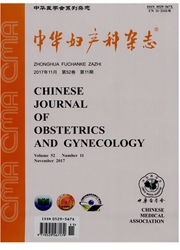

 中文摘要:
中文摘要:
目的探讨WWOX基因对卵巢上皮性癌(卵巢癌)细胞黏附能力的影响。方法采用RT-PCR技术、蛋白印迹法检测WWOX基因转染的卵巢癌PEO1细胞WWOXmRNA和蛋白的表达;采用黏附实验检测WWOX基因转染的PEO1细胞对纤连蛋白(FN)介导的黏附性。将WWOX基因的小分子RNA(siRNA)转染入具有内源性WWOX基因表达的卵巢癌A2780细胞,黏附实验检测细胞黏附性的变化。结果WWOX基因转染的PEO1细胞(H6、H7、H8细胞)均有WWOXmRNA的表达,也均有WWOX蛋白的表达。H6、H7、H8细胞在FN包被的培养孔中培养2h,其黏附性分别为0.098±0.003、0.091±0.004、0.099±0.003,较未转染的PE01细胞(0.211±0.007)明显减小,分别比较,差异有统计学意义(P〈0.01)。转染WWOXsiRNA后,转染组A2780细胞在FN包被的培养孔中培养0.5h,其黏附性为0.059±0.005,明显高于空白对照组(0.029±0.003),两组比较,差异有统计学意义(P〈0.05)。结论WWOX基因能抑制卵巢癌细胞的黏附能力,WWOX基因缺失可增强卵巢癌细胞对盆腹腔黏膜的黏附,进而发生盆腹腔的种植及扩散。
 英文摘要:
英文摘要:
Objective To explore the relationship between WWOX gene and attachment and adhesion of ovarian cancer. Methods The expression of WWOX mRNA was detected by RT-PCR, the expression of the WWOX protein was evaluated by western blot in WWOX-transfected PEOI cells ( H6, H7, H8 cell) and vector-transfected control cells (vec-1, vec-2 cell). Attachment assay was used to assess the adhesion of the transfection in PEO1 cells via culturing the cells on the pre-coated fibronectin wells. RNA interference (RNAi) was used to knockdown the endogenous expression of WWOX in the A2780 ovarian cancer cell line by liposome. Attachment assay was detected the adhesion to fibronectin after gene silencing. Results RT-PCR showed that expression of mRNA WWOX in exon9 was in all transfection cells ( H6, H7, H8, vec-1, vec-2 cell). Western blot showed that expression of WWOX protein was in the WWOX- transfected cells (H6, H7, H8 cell), but not in the vector-transfected cells (vec-1, vec-2 cell).Attachment assay showed that H6, H7, H8 cell (0. 098±0. 003, 0. 091 ±0. 004, 0. 099 ±0. 003) adhered more slowly to fibronectin than vec-1, vec-2 cell (0. 185 ± 0. 003, 0. 175±0. 006 ) and non-transfected PEO1 cell (0. 211±0. 007), and demonstrated significantly reduced adhesion after 2 hours (P 〈 0. 01 ). A2780 adhesive cells that WWOX gene be knockdown was 0. 059± 0. 005, adhered more significantly rapid than those untreated cells that was 0. 029 ± 0. 003 after treated 30 minutes ( P 〈 0. 05 ). Conclusions WWOX gene can suppress adhesion to fibronectin in ovarian cancer cells. This suggests an important role for loss of WWOX gene in promoting attachment and adhesion of ovarian cancer cells on loco-regional peritoneum, and further resulting in enhancing loco-regional peritoneal tumor invasiveness and spread.
 同期刊论文项目
同期刊论文项目
 同项目期刊论文
同项目期刊论文
 期刊信息
期刊信息
